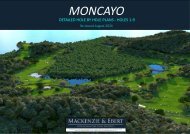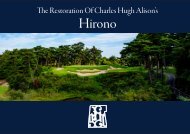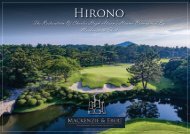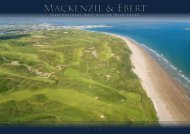You also want an ePaper? Increase the reach of your titles
YUMPU automatically turns print PDFs into web optimized ePapers that Google loves.
Biography <strong>Of</strong> <strong>Charles</strong> <strong>Hugh</strong> Alison<br />
<strong>Charles</strong> <strong>Hugh</strong> Alison was born on the 5th of March 1883 in Preston, Lancashire.<br />
He was educated at Malvern College in Worcestershire. He then attended New College, Oxford for two years,<br />
achieving two blues for playing for Oxford University against Cambridge University in the 1903 and 1904<br />
University Golf Matches.<br />
It is believed that Alison began to assist Harry Colt from 1906 in his course design business. In 1908, Alison<br />
was appointed secretary of Stoke Poges Golf Club (now called Stoke Park), a course which Colt designed and<br />
opened in 1909.<br />
After the war in 1918, Alison was assigned to a committee (in place of Colt) tasked with designing the four<br />
remaining holes to be designed at Pine Valley following the death of George Crump. Alison produced a five<br />
page report which led to significant changes to the course, including the rebuilding of five greens.<br />
Over the following nine years in the US, Alison designed more than twenty new courses including the Country<br />
Club of Detroit. However, it appears his experience at Pine Valley was perhaps most important in shaping his<br />
beliefs for future design work.<br />
In 1929, Colt was approached by Komo Otani from Tokyo GC.<br />
Otani studied in England and, like many other Japanese golfers<br />
who studied in Britain, he admired the courses outside London,<br />
many of which had been designed by Colt. This led to Colt<br />
agreeing to the commission and he demanded a fee of £1,500<br />
plus expenses. However, concerned by the long voyage, Colt<br />
sent Alison in his place.<br />
Alison arrived in Japan on the 1st December 1930 on a boat from<br />
California with George Penglase, an American greenkeeper who<br />
would stay on as construction foreman after Alison returned to<br />
the US. His first project was Tokyo Golf Club located on relatively<br />
flat terrain north of Tokyo which was opened in 1932. He then<br />
designed <strong>Hirono</strong>, which had a much more interesting terrain<br />
and was regarded as possibly the best golf course in Japan.<br />
He also designed the Fuji course at Kawana, though this was not completed until 1936, remodelled<br />
five holes on the (now) East Course at Kasumigaseki GC, originally created by amateur architect Kinya<br />
Fujita, and almost completely redesigned the Naruo course near Osaka.<br />
Throughout the 1930s, Alison continued to travel the world, working on the Royal Selangor course in<br />
Kuala Lumpur. He then worked in countries such as Morocco, Australia, New Zealand and South Africa.<br />
After the Second World War, in which Alison worked in ciphers, he moved to South Africa, completing<br />
minor works at some other courses. He died, aged 70, in Johannesburg on the 20th of October 1952.

















